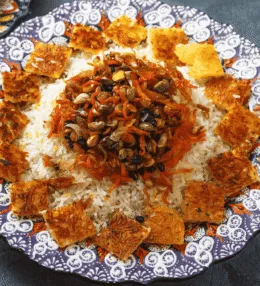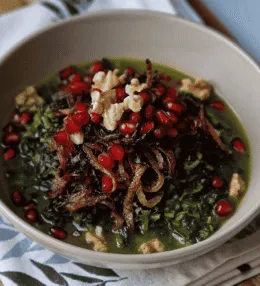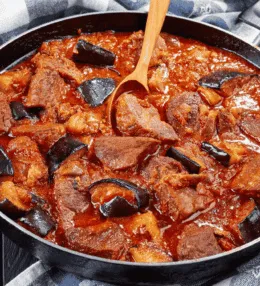
- View
Table of Contents
ToggleKuih Talam is one of those treats that immediately pulls you in with its vibrant colour and gentle aroma. Found across Malaysia, particularly at morning markets and kuih stalls, this two layered pandan and coconut cake is a favourite for its balance of texture and flavour.
Whether you’re after something sweet but not cloying, or simply want a glimpse into Malaysia’s diverse food culture, Kuih Talam offers a delicious place to start. Its name, ‘talam’, meaning ‘tray’, refers to the way it’s traditionally steamed in shallow pans before being cut into neat, glossy squares.
Want to dive deeper into Malaysian Cuisine? Don’t miss our post on 27 Traditional Malaysian Foods to Try
What Is Kuih Talam?
Kuih Talam is a traditional Malaysian dessert made with two distinct layers. The green bottom layer is infused with pandan, giving it its signature colour and subtle floral scent. The white top layer is rich with coconut milk and slightly salty, providing a contrast that keeps each bite interesting.
Both layers are steamed together, resulting in a soft yet firm texture that holds its shape but melts in your mouth. This kuih is usually eaten at room temperature and often enjoyed as part of a spread with other traditional sweets.
It is a common sight during celebrations, family gatherings, and afternoon tea breaks, where it’s appreciated not only for its flavour but also for its visual appeal. Its glossy finish and neat layers make it just as pleasant to look at as it is to eat.
Ingredients and Taste
Kuih Talam is made from a base of rice flour, green pea flour or tapioca flour, coconut milk, and sugar. The pandan layer combines rice flour with pandan juice and sugar, creating a fragrant and slightly chewy texture.
The top coconut layer uses more coconut milk and is thickened with rice flour, with a pinch of salt added to create a savoury note that balances the sweetness below. What makes Kuih Talam stand out is that contrast. The bottom is sweet and aromatic, while the top is creamy with a gentle saltiness.
It’s not overpowering on either end, making it ideal for those who appreciate balance rather than boldness in their desserts. The soft, springy bite adds another layer of satisfaction, making it hard to stop at just one piece.
A Taste of History
Kuih Talam is part of the larger family of kuih, a category of bite sized Malaysian and Peranakan sweets and snacks. The technique of layering and steaming is a long standing tradition in Southeast Asian kitchens, developed as a practical way to cook with local ingredients like rice flour and coconut.
The inclusion of pandan is also deeply rooted in the region’s culinary identity, as the leaf has long been used to flavour and scent both sweet and savoury dishes.
Though it’s enjoyed widely across ethnic groups in Malaysia, Kuih Talam is especially associated with Nyonya, or Peranakan cuisine, a culinary style that blends Chinese and Malay traditions.
Over time, this simple yet refined dessert has become a symbol of cultural harmony, showcasing how flavours, techniques and ingredients from different heritages can come together so effortlessly.
How To Make Kuih Talam
Ingredients:
Green Pandan Layer (Base Layer):
- 100g rice flour
- 30g green mung bean flour (or hoen kwe flour)
- 100g caster sugar
- 1/4 tsp salt
- 250ml pandan juice (blend 6 pandan leaves with 250ml water, strain)
- 200ml water
- A few drops of pandan essence (optional, for deeper colour and aroma)
White Coconut Layer (Top Layer):
- 50g rice flour
- 1 tbsp cornflour
- 1/4 tsp salt
- 250ml thick coconut milk (from first pressing or canned)
Instructions
Step 1/9
To begin, prepare your steaming setup by bringing water to a boil in a large steamer. Lightly grease an 18cm square or round heatproof pan with neutral oil, then place it inside the steamer to preheat. This helps the base layer cook evenly without sticking.
Step 2/9
In a large mixing bowl, combine rice flour, mung bean flour, sugar, and salt for the pandan layer. Stir in the pandan juice and water gradually, whisking continuously until smooth and free of lumps. Add a few drops of pandan essence if the colour is too pale. Let the batter rest for 5–10 minutes to hydrate the flour.
Step 3/9
Strain the pandan batter through a fine sieve to ensure a silky texture. Pour the mixture into the preheated pan in the steamer. Steam over medium heat for 25 minutes, or until the surface is firm to the touch. Avoid opening the lid during the first 15 minutes to prevent sinking.
Step 4/9
While the base is steaming, prepare the white coconut layer. In a clean bowl, mix rice flour, cornflour, and salt. Slowly whisk in the thick coconut milk until a smooth batter forms. Straining is recommended here too for the smoothest finish.
Step 5/9
Once the pandan layer is set and firm, gently pour the coconut layer over it using the back of a spoon to prevent it from disturbing the green layer. Ensure an even surface by gently tilting the pan side to side.
Step 6/9
Cover the steamer lid with a clean cloth (to catch water droplets), then steam the kuih over medium to low heat for another 15 minutes or until the top layer is set. The surface should appear matte and firm, not wobbly.
Step 7/9
After steaming, switch off the heat and leave the kuih inside the steamer with the lid ajar for 10 minutes. This helps prevent sudden temperature drops, which can cause the top layer to wrinkle.
Step 8/9
Transfer the pan to a wire rack and allow the kuih to cool completely, ideally for 2–3 hours, before slicing. The cooling time is essential for clean cuts and a firm texture.
Final step/9
To serve, cut the kuih into bite sized diamond or square pieces using a lightly oiled knife to prevent sticking. Kuih Talam is traditionally enjoyed at room temperature, either on its own or with hot tea. For a more festive touch, garnish with a fine sprinkle of desiccated coconut or serve on banana leaves for aroma and presentation.
Cooking Tips for Perfect Kuih Talam
- Fresh pandan juice delivers authentic fragrance, avoid bottled versions unless absolutely necessary.
- Always strain the batter to remove clumps for a smooth, pudding like texture.
- Use thick coconut milk for the top layer to achieve a creamy, luscious contrast.
- Keep the steamer lid covered with cloth to avoid water droplets from pitting the surface.
- Don’t rush the cooling, Kuih Talam cuts best when fully cooled and slightly firm.
- Slice with a greased knife for clean, sharp edges that showcase the two layers.

Malaysian Kuih Talam (Pandan Coconut Cake)
Equipment
- Blender or food processor
- Fine Strainer or Sieve
- 2 Mixing bowls
- Whisk
- Measuring cups and spoons
- Steamer or Large Wok with Lid
- 18cm (7-inch) Heatproof Pan or Cake Tin
- Silicone or Rubber Spatula
- Clean Kitchen Cloth or Tea Towel
- Cooling Rack
- Sharp knife
- Small Brush or Paper Towel
Ingredients
Green Pandan Layer (Base Layer):
- 100 g rice flour
- 30 g green mung bean flour or hoen kwe flour
- 100 g caster sugar
- 1/4 tsp salt
- 250 ml pandan juice blend 6 pandan leaves with 250ml water, strain
- 200 ml water
- A few drops of pandan essence optional, for deeper colour and aroma
White Coconut Layer (Top Layer):
- 50 g rice flour
- 1 tbsp cornflour
- 1/4 tsp salt
- 250 ml thick coconut milk from first pressing or canned
Instructions
- To begin, prepare your steaming setup by bringing water to a boil in a large steamer. Lightly grease an 18cm square or round heatproof pan with neutral oil, then place it inside the steamer to preheat. This helps the base layer cook evenly without sticking.
- In a large mixing bowl, combine rice flour, mung bean flour, sugar, and salt for the pandan layer. Stir in the pandan juice and water gradually, whisking continuously until smooth and free of lumps. Add a few drops of pandan essence if the colour is too pale. Let the batter rest for 5–10 minutes to hydrate the flour.
- Strain the pandan batter through a fine sieve to ensure a silky texture. Pour the mixture into the preheated pan in the steamer. Steam over medium heat for 25 minutes, or until the surface is firm to the touch. Avoid opening the lid during the first 15 minutes to prevent sinking.
- While the base is steaming, prepare the white coconut layer. In a clean bowl, mix rice flour, cornflour, and salt. Slowly whisk in the thick coconut milk until a smooth batter forms. Straining is recommended here too for the smoothest finish.
- Once the pandan layer is set and firm, gently pour the coconut layer over it using the back of a spoon to prevent it from disturbing the green layer. Ensure an even surface by gently tilting the pan side to side.
- Cover the steamer lid with a clean cloth (to catch water droplets), then steam the kuih over medium to low heat for another 15 minutes or until the top layer is set. The surface should appear matte and firm, not wobbly.
- After steaming, switch off the heat and leave the kuih inside the steamer with the lid ajar for 10 minutes. This helps prevent sudden temperature drops, which can cause the top layer to wrinkle.
- Transfer the pan to a wire rack and allow the kuih to cool completely, ideally for 2–3 hours, before slicing. The cooling time is essential for clean cuts and a firm texture.
- To serve, cut the kuih into bite sized diamond or square pieces using a lightly oiled knife to prevent sticking. Kuih Talam is traditionally enjoyed at room temperature, either on its own or with hot tea. For a more festive touch, garnish with a fine sprinkle of desiccated coconut or serve on banana leaves for aroma and presentation.
Nutrition
You May Also Like






